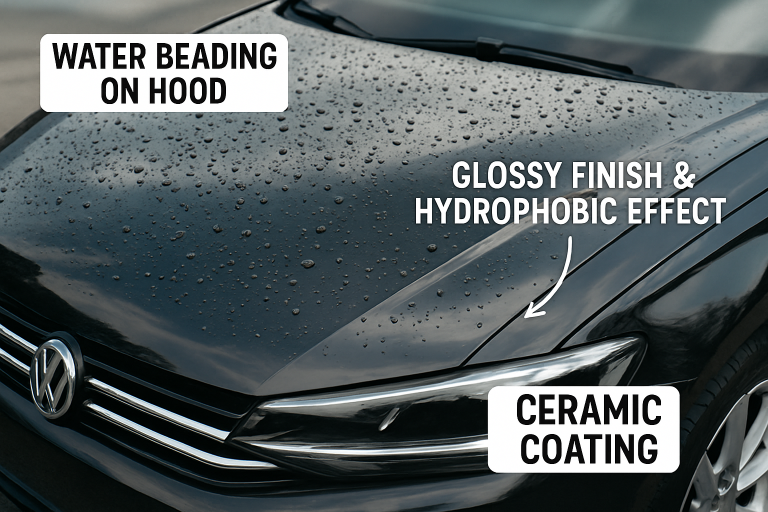Key Takeaways:
- Ceramic coatings provide a durable shield against environmental hazards, enhancing vehicle longevity.
- They offer hydrophobic properties, making maintenance easier and preserving the vehicle’s aesthetic appeal.
- Proper application and maintenance are crucial for maximizing the benefits of ceramic coatings.
Introduction
Owning a car is an investment, and protecting its appearance is vital to preserving its value and driving enjoyment. While regular washing and waxing can help maintain your car’s exterior, these methods often fall short when exposed to the harsh realities of everyday road use, such as UV rays, acid rain, dirt, and debris. Increasingly, car owners are turning to advanced protective solutions, such as ceramic coating, to safeguard and even enhance their vehicle’s finish.
Ceramic coatings have emerged as a leading option for long-term vehicle protection due to their ability to bond with the paint chemically, creating a durable shield against everyday damage and environmental factors. This innovation results in reduced maintenance, a shinier appearance, and superior longevity compared to traditional protective products. This article outlines the reasons behind the growing popularity of ceramic coatings among car enthusiasts and everyday drivers, delves into their operational mechanisms, and provides essential tips for achieving the best results, whether for maintaining a showroom finish or simplifying cleaning. Additionally, it highlights the demand for interior protection in specific climates or urban settings, focusing on minimizing sun damage, reducing glare, and improving privacy.
What Are Ceramic Coatings?
Ceramic coatings are sophisticated liquid polymer solutions that create a chemical bond with a vehicle’s factory paint, forming a robust and hydrophobic protective layer. This advanced technology utilizes nanotechnology to fill microscopic imperfections in the paint, yielding a smooth and glossy finish that effectively repels water, dirt, and debris. In addition to enhancing the vehicle’s appearance, ceramic coatings provide substantial long-term protection against a range of environmental hazards, including UV rays, road salt, bug residue, and minor scratches. Unlike conventional waxes or sealants that degrade quickly, these coatings can endure for two to five years or more with proper maintenance. To maximize your vehicle’s protection and comfort, pair your ceramic coating with complementary treatments, such as professional window tinting Tega Cay. This combination not only enhances your car’s appearance but also helps regulate interior temperature and reduce glare. With proper maintenance, your vehicle will retain its showroom shine and protection for years to come.
Benefits of Ceramic Coatings
- Durable Protection: Ceramic coatings deliver robust protection that far outlasts traditional waxes. This shield defends against environmental elements, minimizing paint degradation and keeping your vehicle looking newer for longer.
- Hydrophobic Qualities: Water effortlessly beads and sheets off the coated surface, which not only simplifies washing but also reduces the risk of swirl marks from trapped grit or contaminants.
- UV Resistance: The sun’s rays are a major contributor to paint fading and oxidation. Ceramic coatings block significant levels of UV radiation, helping the paint retain its depth and vibrancy for years to come.
- Enhanced Gloss and Shine: In addition to protection, one of the most noticeable benefits is a high-gloss, deep luster that rivals a freshly waxed appearance, accentuating your vehicle’s color and features.
- Chemical Resistance: The coating provides a strong defense against acidic or alkaline contaminants, such as those found in bird droppings, tree sap, or road salts, thereby reducing the likelihood of etching and staining.
Additional benefits include increased resale value and fewer professional paint corrections over the vehicle’s lifespan. According to Car and Driver, ceramic coatings are considered a long-term solution for car owners aiming to save time and money on frequent detailing.
Application Process
Achieving the best from a ceramic coating relies on careful preparation and application:
- Clean and Decontaminate: Start with a thorough wash, removing all dirt, grease, and grime, followed by decontaminants such as clay bars or iron removers.
- Paint Correction: Any swirl marks, scratches, or imperfections should be corrected with polishing to provide the smoothest possible base for the coating.
- Apply Coating: The ceramic product is applied using a microfiber applicator, section by section, ensuring an even, thin layer. Excess is often buffed off after a short dwell time.
- Curing: Allow the coating to cure according to the manufacturer’s recommendations—typically between 24 and 48 hours—protecting the car from exposure to moisture and pollutants during this period.
Though many DIY kits are available, a professional application may yield longer-lasting and more uniform results, particularly for first-time users.
Maintenance Tips
- Routine Washing: Use a pH-neutral car shampoo and the two-bucket method to minimize the risk of scratching the vehicle’s coating surface.
- No Abrasive Cleaners: Avoid using strong chemicals, harsh brushes, or rough towels that might wear away the ceramic layer.
- Periodic Inspection: Check regularly for bead loss or surface changes, and apply a top-up maintenance spray as needed to refresh the hydrophobic properties.
- Gentle Drying: Always use clean, soft microfiber towels to dry the vehicle after washing, minimizing the risk of marring the finish.
Well-maintained ceramic coatings can outlast their expected service life, continuing to provide shine and protection for years.
Common Misconceptions
There are several myths regarding ceramic coatings. While some advertisements suggest these products make vehicles completely scratch-proof, the truth is that ceramic coatings are highly resistant but not invincible; they primarily protect against minor abrasions and environmental hazards. Another common misconception is that coated vehicles require no washing. In reality, regular (but gentler) cleaning is essential, as ceramic coatings do not eliminate the buildup of dust, pollen, or road grime—they make their removal easier.
Choosing the Right Coating
Selecting a ceramic coating involves weighing several factors:
- Quality and Brand: Opt for reputable brands with a proven track record of longevity and consistently positive customer feedback.
- DIY vs. Professional Application: DIY kits may be more affordable and accessible, but professional-grade coatings often come with warranties and superior performance.
- Warranty and Support: Higher-end products and professional applications may provide multi-year warranties for added peace of mind.
- Intended Use: Consider how, where, and how often your car is driven; daily drivers may require more frequent maintenance or a higher-grade coating.
Conclusion
Ceramic coatings are a powerful solution for drivers looking to protect their investment, enhance their vehicle’s shine, and reduce day-to-day maintenance. By understanding their advantages, proper application, ongoing care, and common myths, you can maximize the benefits and keep your car turning heads and resisting the elements for years to come. For those seeking further enhancements, pairing ceramic coatings with related upgrades, like professional window tinting, offers a holistic approach to automotive preservation and enjoyment.

